Case Studies
A solar-powered waterfall in the mountains on a remote Greek Island.
Squadron Leader Paul Delahunt-Rimmer of Special Interest Holidays International took us through the project ...
What made you decide on a solar powered waterfall?
I have been an ardent pond constructor for over 40 years. My parents lost many postmen down my increasingly ambitious projects in the garden back home. The window-cleaners of course came self-equipped to extract themselves.
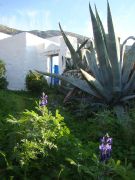
We live on the remote island of Amorgos (pop 1,800) Greece in a small village in the mountains with just three residents.
We have no road or mains water or electricity.
Our main house is heated by a wood burning stove and light is from oil lamps and candles.
The full story can be read in ‘Out of the Rat Race into the Fire’.
We also own a ruin next to the house. One room is renovated as a store room. The courtyard was very overgrown and full of earth and rocks which had fallen from the walls of the ruin. The houses are built with undressed rock from the surrounding mountainside held together with earth and lime.
As tour operators, Special Interest Holidays International, specialising in Greece in walking holidays for, obvious reasons, year 2012 is a disaster. I needed a project to keep me out of the local taverna.
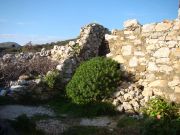
I decided to try to clear some of the vegetation and rubble in the courtyard of the ruin to at least provide an area where we could swing a cat (there are plenty around).
In trying to remove a very reluctant euphorbia bush I discovered a rain drainage channel along a wall which on further excavation led to a soak-away. Further archaeological activity revealed a 300 year old stone cobbled courtyard.
To encourage my taverna avoidance program my wife suggested that we should try to establish a courtyard garden. The only way to inspire my activities was to agree for me to regenerate the drainage channel and pit by building one of my beloved ponds and a waterfall.
How did the sourcing work out?
This project, of course, required a pump and a power source. For the main house we have a small solar system which provides enough power to recharge mobile phones etc. and a small electric light in the bathroom. We really needed a separate system for our ruin. We already had a small bilge pump for a boat. There is a small selection of batteries on the island to purchase but no solar systems.
A ‘Google’ search came up with a number of solar energy companies in the UK. After refining the search to companies who would ship abroad and supply the required system; Select Solar in the UK came up.
What did you do for technical advice & supply of the items?
I informed Select Solar that I needed a solar system to run a submersible pump (Johnson L550) 12v 10w 3amps. It would be run about 2 hours a day in the summer in Greece (12 hours blazing sun). I asked if their 10w DIY Kit would do the job. I also asked advice on batteries. I said that we had available a 12v 45 AH or a 12v 20 AH.
I received a reply advising that I would require their slightly larger 20w Solar Power DIY kit and suggesting the larger battery. Their normal carrier would not deliver to such a remote location but they sourced a courier that would. After a little confusion with said courier, with our delivery requirements (the nearest taverna), the order was despatched and delivered within an amazing four days. It takes us three days, including nine hours on a ship, to get to the UK. It was light enough to carry up the mountains. Heavy loads require a donkey.
How long did the project take?
It has been estimated that the whole project took over 150 man-hours. However much of this was due to careful excavation and removal of spoil and the building of other features in stone. The pond took just a few days. Many hours were also taken up selecting the correct rough rocks from the piles available to fit into building walls.
A combination of mortars were used from the traditional soil and lime to sand and cement. Hay, both recycled (dry donkey droppings) and freshly dried were used as bonding materials.
The pond would have been lined with butyl but this was not available so a double layer of PVC was used as a temporary measure.
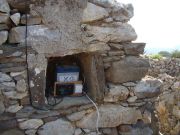
And the electrics?
The electrical installation was easy given the instructions supplied by Select Solar with their DIY kit.
It was also helped considerably by the generous amount of suitable wire and connectors which came with the comprehensive installation gear.
The whole wiring and connecting up took a little over two hours.
In the UK we need careful positioning of solar panels for the best efficiency. What experience did you have with this?
The correct angle for our solar panel at our latitude of 36° 55’ N, should be around 70° for the summer months (78°-54° June to September).
Our village is protected as the Greek equivalent of ‘An area of outstanding natural beauty’. We have a local agreement, in other words I have requested, that any solar panels in the village should not be visible. The main panel on our house is flat on the roof as are three other panels in the village. One holiday home has the panel raised but on the ground screened by shrubbery.
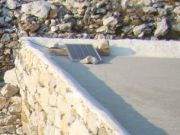
With over 12 hours of sun every day in the summer one can afford to be uneconomical with the rays available.
I have put approximately 10° tilt on the pond solar panel.
The technologically advanced controller supplied with the DIY kit from Solar Select shows it to be functioning very efficiently.
And the plumbing?
The piping and stopcocks were sourced locally. There are three outlets from the pump at varying levels. The lowest supplies the drainage channel leading to the water fall. Half a metre above this is a water spout into the channel. At about one meter above water level is a higher spout straight into the pond.
As the pump is not a dedicated pond pump but a powerful bilge pump it supplies 55 litres of water a minute at zero elevation. This decreases on an exponential scale up to four metres. The only way to control the flow was to fit stopcocks and restrictors on the three outlets and adjust by trial and error. This resulted in a few personal dousing downs and a considerable loss of water at very high speed which endangered some of the lower flying eagles.
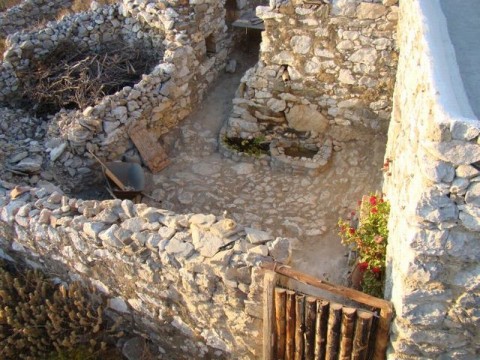
This is a rather selfish project in that only private guests will get to enjoy this new walled garden.
Our village is very popular with walkers and it is not uncommon to find people leaning over your wall taking photographs of the house, patio and apparent inherently eccentric owners due to their peasant-like life style.
The ruin courtyard is completely enclosed with the wall rebuilt and a high gate installed.
The gate was also built from scavenged materials. In this case from the stalk (8 metres) of a century plant which grew on our main house patio.
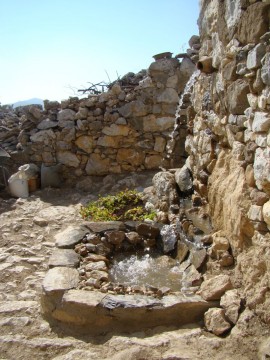
Do you add anything to the water to keep it clear?
For water we rely totally on the very small rainfall a year (340 mm). This is collected in a tank under our patio. The pond was filled and is maintained from this. This is pure enough to drink.
Due to virtually no pollutants, either organic or chemical, the pond remains surprisingly clear despite the strong sunlight. To this end no filtration system is employed
What's next on the project list?
For six months of the year we live in the Okavango Delta in Botswana. Our house there is many miles out of Maun in the bush with a large platform which goes out over the Thamalakane River. I already had plans to turn this in to a patio garden with a pond and waterfall. This will be the project for when we return for our northern hemisphere winter.
The water will be pumped straight from the river and back into it via a waterfall and pond. It will require a pump that will be both crocodile and hippo proof. It may also be a challenge to Solar Select to deliver the same system for us to a remote location in the African bush!
Paul Delahunt-Rimmer
Squadron Leader
Special Interest Holidays International
10/07/12



